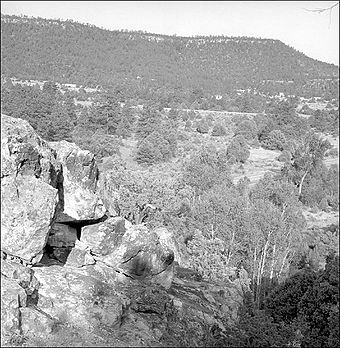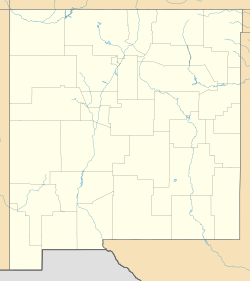Glorieta Pass Battlefield facts for kids
|
Glorieta Pass Battlefield
|
|

Photo from Sharpshooter's Ridge, just north of Pigeon's Ranch. This was the location of the Union right flank during the last day's battle.
|
|
| Location | Santa Fe County, New Mexico, USA |
|---|---|
| Nearest city | Pecos, New Mexico |
| Area | 444 acres (180 ha) |
| Built | 1862 |
| Part of | Pecos National Historical Park (ID66000485) |
| NRHP reference No. | 66000486 |
Quick facts for kids Significant dates |
|
| Added to NRHP | October 15, 1966 |
| Designated NHL | November 5, 1961 |
The Glorieta Pass Battlefield is a famous place in New Mexico. It was where an important battle happened during the American Civil War. This battle stopped the Confederate army from taking control of the western United States.
The Battle of Glorieta Pass took place from March 26 to 28, 1862. It happened at Glorieta Pass, a mountain pass on the old Santa Fe Trail. Today, Interstate 25 cuts through the pass and the battlefield. Parts of the battlefield are now protected. They are managed by the National Park Service as part of Pecos National Historical Park. This area was named a National Historic Landmark in 1961.
Contents
About the Battlefield
The protected parts of the battlefield are made of two main areas. One area is about 294-acre (1.19 km2) on the west side of Glorieta Pass. The other is about 150-acre (0.61 km2) on the east side.
Some parts of the battlefield have been changed over time. A railroad and Interstate 25 were built through them. The eastern part of the battlefield is north of I-25. New Mexico State Road 50 goes through it, following the old Santa Fe Trail.
At the eastern end of this section was Pigeon's Ranch. This was a historic stop along the trail. Only the foundations of the ranch remain today. The western section of the battlefield is mostly between I-25 and the railroad tracks. It is near the small town of Cañoncito.
The Battle of Glorieta Pass
The Battle of Glorieta Pass happened because the Confederate army wanted to control the western United States. Confederate forces were led by Brig. Gen. Henry H. Sibley. They had already reached Santa Fe. They defeated a Union force at Valverde in February 1862.
William Gilpin, who was the governor of the Colorado Territory, gathered volunteer soldiers. These soldiers were sent to help defend Fort Union. This fort was the next target for the Confederate army.
The Union and Confederate forces fought a battle that didn't have a clear winner at first. The Union forces had to move back north. However, they successfully destroyed the Confederate supply train. This was a big problem for the Confederates. Without supplies, they had to retreat. They ended up going all the way back to Texas.
Protecting the Battlefield
In 1993, a group called the Civil War Sites Advisory Commission made a report. This group was asked by Congress to find important Civil War sites. They also had to decide how important each site was. Then, they gave ideas to Congress on how to protect these places.
There were about 10,500 actions during the U.S. Civil War. The Commission identified 384 of these as "principal battles." They rated these battles based on their importance and how much they were at risk of being lost.
The Battle of Glorieta Pass received the highest rating. It was called "Priority I (Class A)." This means it was a very important battle that directly affected the war. This rating put Glorieta Pass on the same level as famous battles like Gettysburg and Antietam.
The "Priority I" rating also meant that Glorieta Pass was one of the most important and most endangered battlefields. Only 10 other battlefields received this top rating. The Commission suggested that Congress should focus on protecting these nationally important battlefields.
Since 1993, parts of the Glorieta Pass battlefield have been managed by the National Park Service. The Glorieta Pass unit, which includes Pigeon's Ranch, is about 20% of the whole battlefield. The other 80% is still privately owned.
Pecos National Historical Park manages the Glorieta Pass Battlefield. A group of citizens called the Glorieta Battlefield Coalition also helps support its preservation.
Some parts of the battlefield were opened to the public in 2012. This was the 150th anniversary of the battle. There are easy paths and signs that explain the history. Some paths are even accessible for everyone.
The Civil War Trust (now part of the American Battlefield Trust) and its partners have also helped. They have bought and protected about 19 acres (0.077 km2) of the battlefield.
Images for kids





